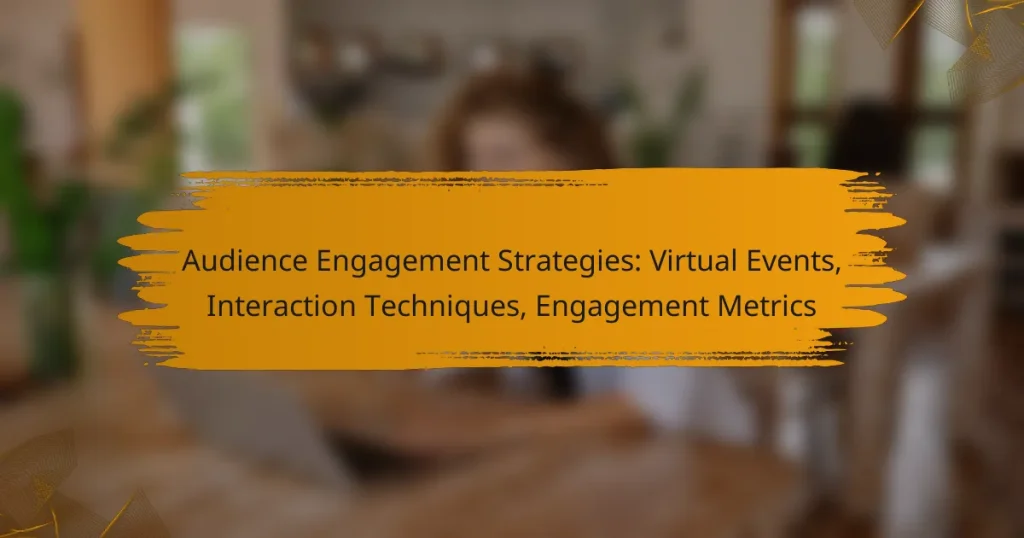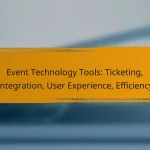In today’s digital landscape, enhancing audience engagement during virtual events is crucial for success. By incorporating interactive elements such as polls, Q&A sessions, and breakout rooms, organizers can foster participation and maintain attendee interest. Additionally, tracking engagement metrics like attendance rates and participant feedback helps refine strategies for future events, ensuring a more dynamic and satisfying experience for all involved.

How to Increase Audience Engagement in Virtual Events?
To increase audience engagement in virtual events, utilize interactive elements that encourage participation and feedback. Strategies such as polls, Q&A sessions, and breakout rooms can significantly enhance interaction and keep attendees involved throughout the event.
Utilize interactive polls
Interactive polls are a powerful tool to engage your audience in real-time. They allow participants to express their opinions or preferences, fostering a sense of involvement. Consider using polls at key moments during your event to gauge audience sentiment or to make decisions collaboratively.
For instance, you might ask attendees to vote on topics for discussion or to provide feedback on a presentation. Aim for a mix of multiple-choice and open-ended questions to capture diverse insights.
Incorporate Q&A sessions
Q&A sessions provide a platform for attendees to ask questions directly, promoting engagement and clarity. Schedule these sessions at strategic points, such as after major presentations, to address audience queries while the material is fresh in their minds.
Encourage participants to submit questions in advance or during the event using chat features. This not only increases interaction but also helps to tailor the discussion to the audience’s interests.
Leverage breakout rooms
Breakout rooms allow smaller groups to discuss topics in depth, enhancing engagement through focused interaction. Use them to facilitate networking, brainstorming, or collaborative problem-solving among attendees.
For effective breakout sessions, provide clear objectives and guidelines. Limit group sizes to around 5-10 participants to ensure everyone has a chance to contribute. After the session, reconvene to share insights with the larger group.
Host live demonstrations
Live demonstrations can captivate your audience by showcasing products or processes in real-time. This interactive format not only informs but also entertains, making the content more memorable.
When planning a demonstration, ensure that it is relevant to your audience’s interests. Use clear visuals and step-by-step explanations to enhance understanding. Encourage questions throughout the demo to maintain engagement.
Implement gamification techniques
Gamification techniques can transform a standard virtual event into an engaging experience. Incorporate elements like quizzes, leaderboards, and rewards to motivate participation and create a fun atmosphere.
For example, you might create a quiz related to the event content, offering prizes for top performers. This not only encourages learning but also fosters a competitive spirit among attendees, enhancing overall engagement.
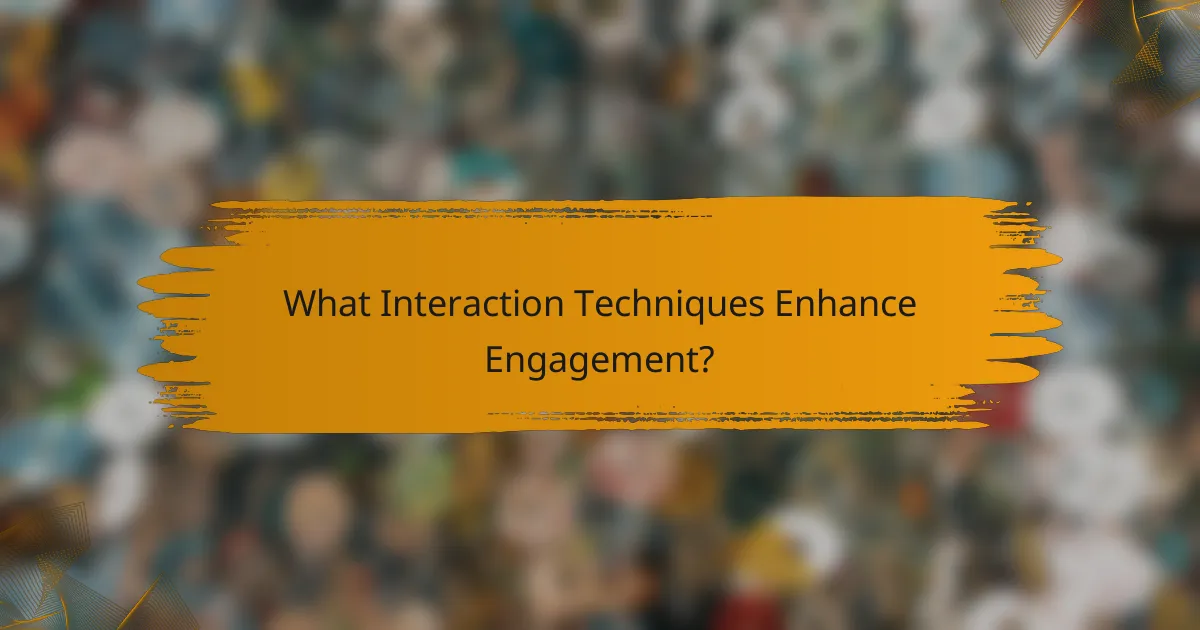
What Interaction Techniques Enhance Engagement?
Interaction techniques that enhance engagement during virtual events include effective use of chat features, encouraging social media sharing, and facilitating networking opportunities. These strategies help create a more dynamic and participatory environment, leading to higher attendee satisfaction and retention.
Use chat features effectively
Utilizing chat features can significantly boost engagement by allowing real-time communication between attendees and presenters. Encourage participants to ask questions, share insights, or comment on presentations, which can create a lively atmosphere.
To maximize effectiveness, designate a moderator to manage the chat, ensuring that relevant questions are addressed promptly. Consider using polls or quick surveys within the chat to gather instant feedback and keep the conversation flowing.
Encourage social media sharing
Social media sharing can amplify the reach of your virtual event and engage a broader audience. Create specific hashtags for your event to streamline discussions and encourage attendees to share their experiences and insights on platforms like Twitter, LinkedIn, or Instagram.
Provide incentives for sharing, such as contests or giveaways, to motivate participants. Highlighting user-generated content during the event can also foster a sense of community and encourage more sharing.
Facilitate networking opportunities
Networking opportunities are crucial for enhancing engagement at virtual events. Implement breakout rooms or dedicated networking sessions where attendees can connect based on shared interests or industries, fostering meaningful conversations.
Consider using platforms that allow for easy scheduling of one-on-one meetings or small group discussions. Providing icebreaker questions or themes can help participants feel more comfortable initiating conversations, leading to valuable connections.

What Are Key Engagement Metrics to Track?
Key engagement metrics to track include attendance rates, participant feedback, and interaction levels. These metrics provide insights into how effectively your virtual events are engaging attendees and can guide improvements for future events.
Monitor attendance rates
Attendance rates reflect the number of participants who join your virtual event compared to the number who registered. A high attendance rate indicates strong interest, while a low rate may signal issues with promotion or scheduling. Aim for an attendance rate of 50-70% of registered participants as a general benchmark.
To effectively monitor attendance, use registration and analytics tools that can provide real-time data. Consider sending reminders or follow-up emails to boost participation rates.
Analyze participant feedback
Participant feedback is crucial for understanding attendee satisfaction and areas for improvement. Collect feedback through surveys or polls immediately after the event to capture fresh insights. Aim for a response rate of at least 20-30% to ensure your data is representative.
Focus on both quantitative ratings and qualitative comments. Look for trends in feedback to identify common strengths and weaknesses, which can inform your planning for future events.
Evaluate interaction levels
Interaction levels measure how actively participants engage during the event, including Q&A sessions, polls, and chat activity. High interaction levels often correlate with greater attendee satisfaction and retention. Tools like live polls and breakout rooms can enhance engagement and provide valuable metrics.
Track metrics such as the number of questions asked, poll participation rates, and chat messages sent. Aim to create opportunities for interaction throughout the event to maintain energy and interest.
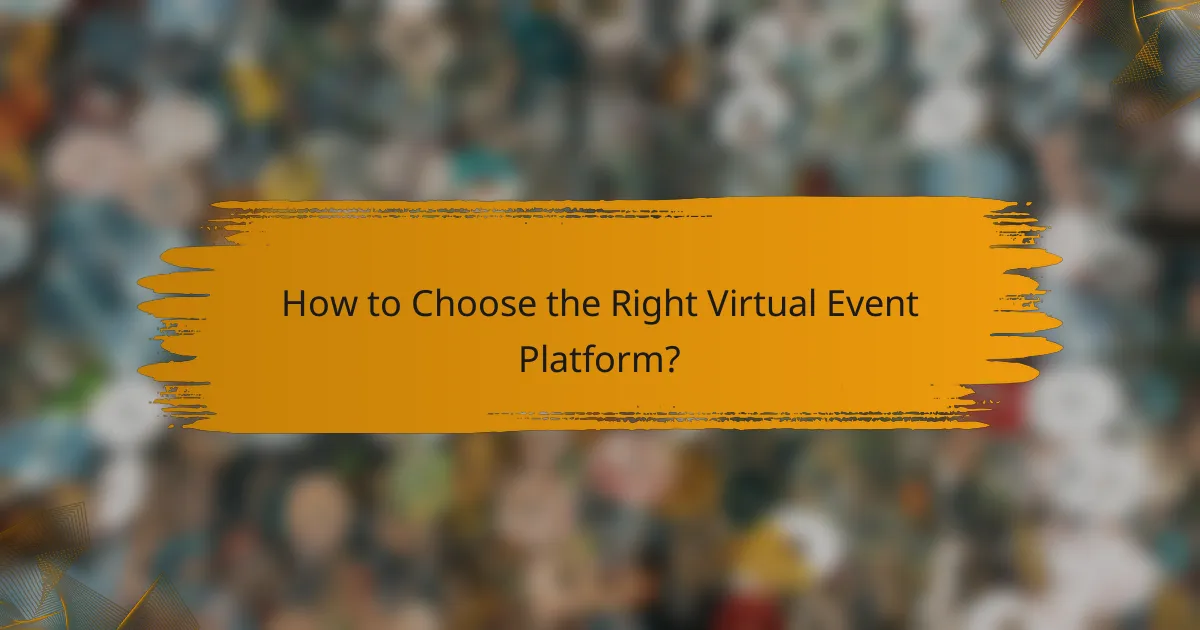
How to Choose the Right Virtual Event Platform?
Choosing the right virtual event platform involves evaluating user experience, pricing, and integration capabilities. A platform that aligns with your event goals and audience needs will enhance engagement and streamline the event process.
Assess user interface and experience
The user interface (UI) and overall experience are crucial for both hosts and attendees. A clean, intuitive design helps participants navigate easily, which can significantly impact engagement levels. Look for platforms that offer customizable layouts and user-friendly features.
Consider conducting a trial run with potential platforms to gauge the experience firsthand. Pay attention to how easily users can join events, interact with content, and access support if needed.
Compare pricing models
Pricing models for virtual event platforms can vary widely, often including subscription fees, pay-per-event charges, or tiered pricing based on features. Assess your budget and the expected return on investment when comparing options.
Some platforms may offer free trials or freemium models, allowing you to test features before committing. Be mindful of any hidden costs, such as additional fees for advanced features or technical support.
Check integration capabilities
Integration capabilities are essential for ensuring that your virtual event platform works seamlessly with other tools you use, such as CRM systems, marketing software, and analytics tools. Look for platforms that offer robust APIs or built-in integrations with popular applications.
Evaluate how well the platform can connect with your existing systems to streamline data sharing and enhance your event’s effectiveness. This can save time and reduce errors in managing attendee information and engagement metrics.
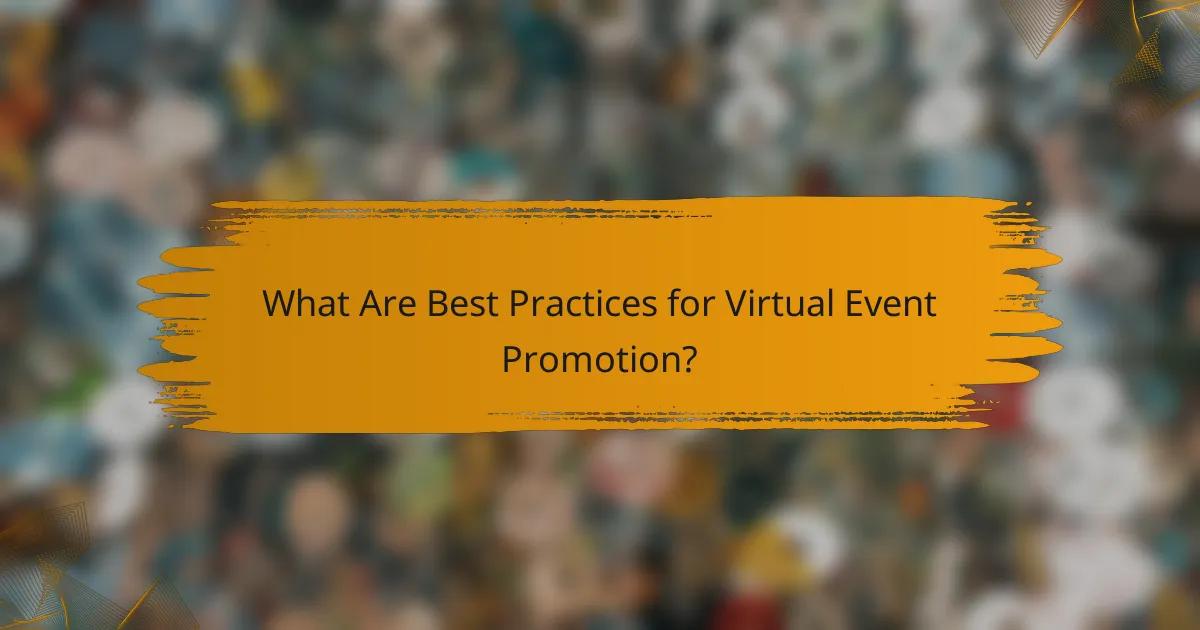
What Are Best Practices for Virtual Event Promotion?
Effective virtual event promotion involves strategic planning and targeted outreach to maximize attendance and engagement. Key practices include leveraging social media, email marketing, and partnerships to reach your audience effectively.
Utilize Social Media Platforms
Social media is a powerful tool for promoting virtual events. Create event pages on platforms like Facebook, LinkedIn, and Twitter to share updates and engage with potential attendees. Use eye-catching visuals and relevant hashtags to increase visibility.
Consider running targeted ads to reach specific demographics. Allocate a budget for social media advertising, focusing on platforms where your audience is most active. A well-timed campaign can significantly boost registrations.
Leverage Email Marketing
Email marketing remains one of the most effective ways to promote virtual events. Build a targeted email list and send personalized invitations that highlight the event’s value. Include clear calls to action and easy registration links.
Segment your audience to tailor messages based on their interests. Follow up with reminder emails as the event date approaches, and consider sending a post-event thank you message to maintain engagement.
Collaborate with Influencers and Partners
Partnering with influencers or organizations in your industry can expand your reach. Collaborate on promotional content or co-host the event to tap into their audience. This can enhance credibility and attract more participants.
Identify potential partners who share similar values and target audiences. Establish mutually beneficial agreements, such as cross-promotion or shared resources, to maximize the impact of your promotional efforts.
Monitor Engagement Metrics
Tracking engagement metrics is essential for assessing the effectiveness of your promotional strategies. Monitor registration rates, social media interactions, and email open rates to gauge interest and adjust your tactics accordingly.
Use tools like Google Analytics or social media insights to gather data. Analyzing these metrics can help identify which channels are most effective, allowing for more focused efforts in future promotions.
